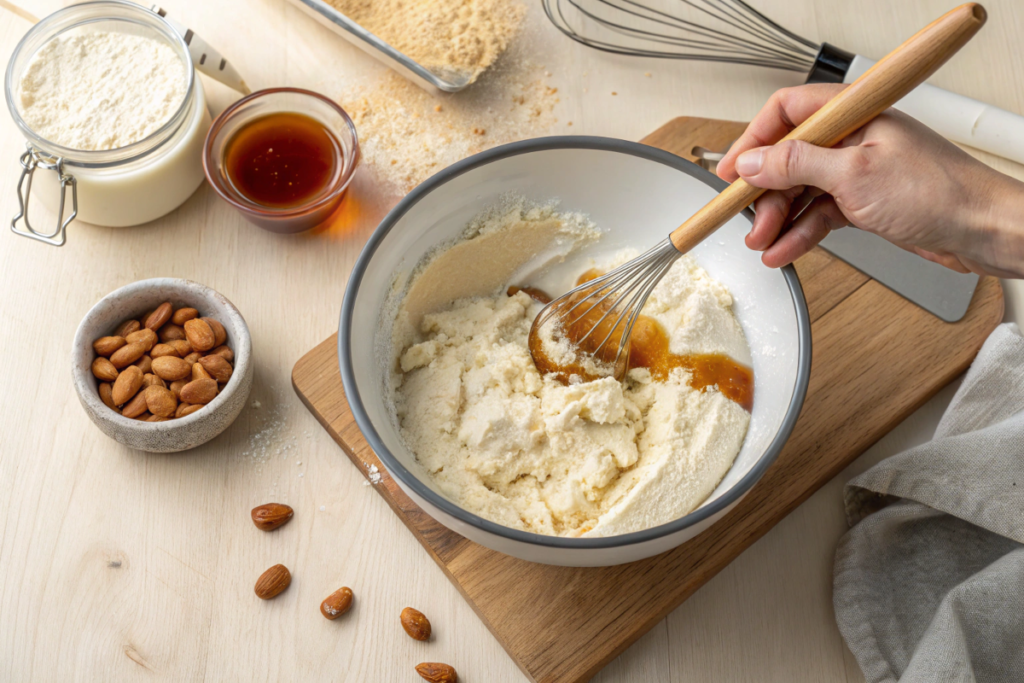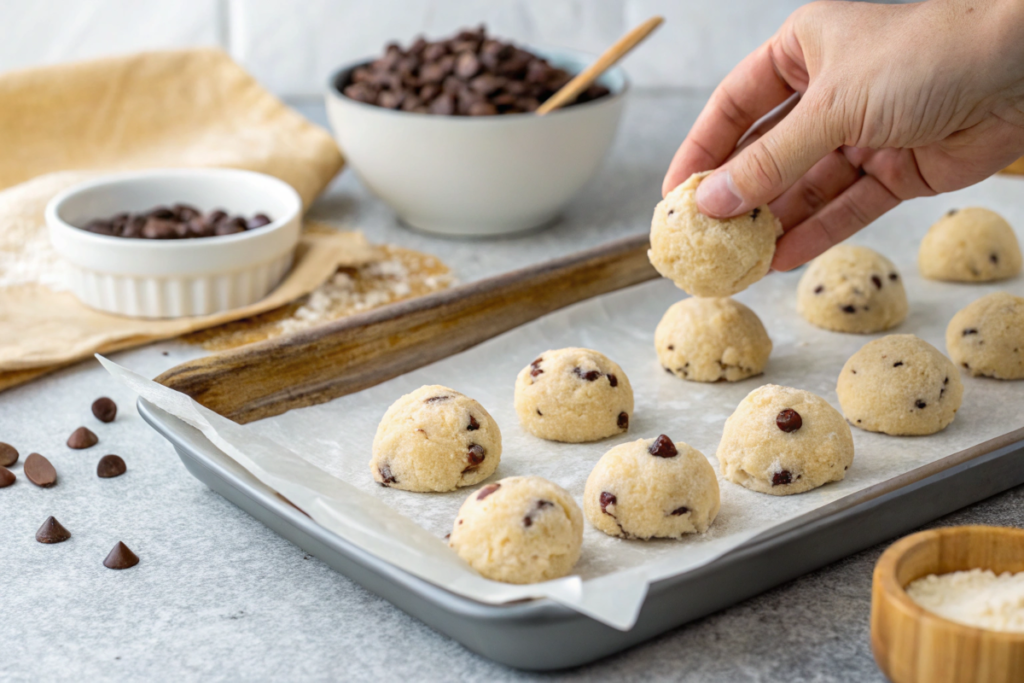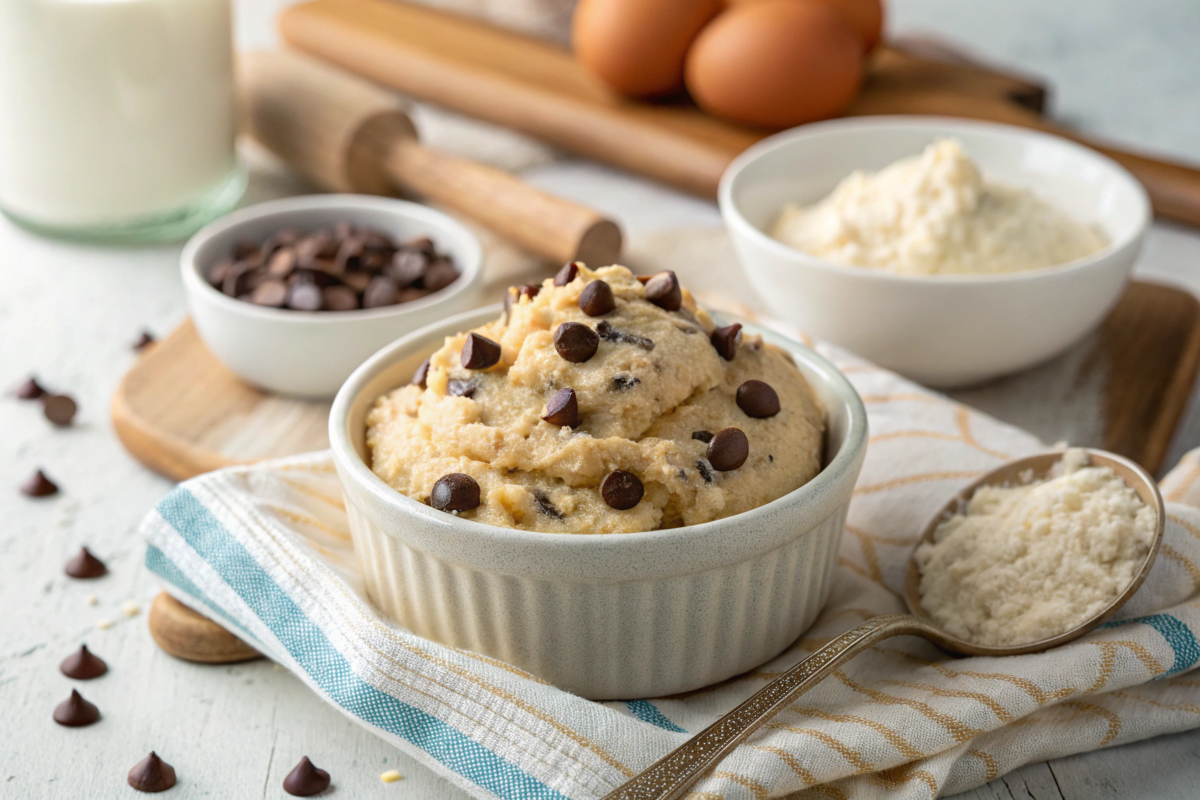If you’re a fan of edible cookie dough but looking for a healthier twist, you’ve come to the right place! Cottage cheese cookie dough is a high-protein, guilt-free alternative to traditional cookie dough. It’s creamy, sweet, and packed with nutrients—all while being ridiculously easy to make.
This guide will walk you through everything you need to know about this delicious treat, from why cottage cheese is a fantastic base to step-by-step instructions, variations, nutritional benefits, and even creative ways to enjoy it. Plus, we’ll answer common questions and troubleshoot any issues you might encounter.
So, whether you’re looking for a post-workout snack, a late-night indulgence, or just a fun new way to enjoy cottage cheese, let’s dive in!
Table of Contents
Introduction to Cottage Cheese Cookie Dough
What is Cottage Cheese Cookie Dough?
Cottage cheese cookie dough is an edible, no-bake treat that swaps traditional butter, eggs, and refined sugar for healthier, protein-rich ingredients. Made primarily with blended cottage cheese, almond flour, and natural sweeteners, this dough mimics the texture and taste of classic cookie dough—without the guilt!
Unlike traditional cookie dough, which can be loaded with unhealthy fats and processed sugars, this version provides a nutrient-dense, high-protein alternative. It’s perfect for those who love cookie dough but want to stay on track with their health goals.
Why is it Trending?
Recently, high-protein cottage cheese recipes have gone viral on social media. From cottage cheese ice cream to savory dips, this ingredient is proving to be incredibly versatile. The cottage cheese edible cookie dough trend took off because:
- It’s packed with protein, making it a great post-workout snack.
- It’s safe to eat raw, unlike traditional cookie dough.
- It satisfies sweet cravings without refined sugar or butter.
- It’s gluten-free and customizable to fit different dietary needs.
Health Benefits Compared to Traditional Cookie Dough
Why choose cottage cheese cookie dough over regular cookie dough? Here are a few key benefits:
✅ Higher in Protein – Cottage cheese is loaded with casein protein, which keeps you full longer.
✅ Lower in Sugar – Natural sweeteners like maple syrup or honey replace refined sugars.
✅ Gut-Friendly – Cottage cheese contains probiotics, which support digestion.
✅ Good Fats & Fiber – Almond flour provides healthy fats and fiber for sustained energy.
Craving cookie dough but want a nutritious option? Cottage cheese cookie dough is the perfect balance of indulgence and health! Stay tuned as we dive into the science behind cottage cheese in Part 2. 🚀
Why Cottage Cheese Makes a Great Base for Cookie Dough
High-Protein Benefits
One of the best reasons to use cottage cheese cookie dough in your recipes is its high protein content. Cottage cheese is naturally rich in casein protein, a slow-digesting protein that helps keep you full longer. This makes it an excellent choice for fitness enthusiasts and anyone looking for a balanced snack.
Compared to traditional cookie dough—loaded with butter and refined sugar—cottage cheese offers a nutrient-dense alternative. With about 13 grams of protein per half-cup, it turns your favorite guilty pleasure into a high-protein, muscle-friendly treat.
Creamy Texture and Taste
At first, the idea of using cottage cheese in cookie dough might sound odd. But when blended, it transforms into a smooth, creamy texture that mimics classic cookie dough batter. The mild flavor of cottage cheese allows it to absorb sweeteners like maple syrup or honey, making it indistinguishable from traditional cookie dough.
Unlike Greek yogurt, which can have a tangy aftertaste, blended cottage cheese provides a neutral base—perfect for combining with vanilla extract, almond flour, and chocolate chips. The result? A luscious, thick, and spoonable dough that tastes like dessert but fuels your body like a protein bar!
Healthier Alternative to Butter or Oil
Most cookie dough recipes rely on butter or oil for richness. While delicious, these ingredients add unnecessary saturated fats and calories. Cottage cheese, on the other hand, provides the same creamy consistency with less fat and more protein.
Plus, it’s packed with calcium, probiotics, and essential amino acids, making it a gut-friendly, metabolism-boosting alternative to traditional cookie dough ingredients.
By swapping butter for blended cottage cheese, you’re reducing empty calories while keeping all the indulgent flavor. Who wouldn’t want that?
Ingredients Needed for Cottage Cheese Cookie Dough

Main Ingredients
To make cottage cheese cookie dough, you only need a handful of simple, wholesome ingredients:
- Cottage cheese – The star ingredient! Opt for full-fat or low-fat for the best texture.
- Almond flour – A gluten-free, high-fiber alternative to all-purpose flour.
- Vanilla protein powder – Enhances the protein content while adding flavor.
- Maple syrup or honey – A natural sweetener that replaces refined sugar.
- Vanilla extract – Enhances the classic cookie dough flavor.
- Pinch of salt – Brings out the sweetness and balances flavors.
- Chocolate chips – Dark chocolate, sugar-free, or mini chocolate chips all work.
These ingredients create a rich, indulgent dough while keeping things nutrient-packed and macro-friendly.
Optional Add-ins for Customization
Want to mix things up? Here are some fun add-ins to personalize your cottage cheese cookie dough:
- Nut butters – Peanut or almond butter adds creaminess and a nutty kick.
- Dried fruits – Raisins, cranberries, or chopped dates provide natural sweetness.
- White chocolate chips – A sweeter twist for white chocolate lovers.
- Chopped nuts – Walnuts, almonds, or pecans for added crunch.
- Cinnamon or cocoa powder – Elevate the flavor profile with a warm, rich taste.
This cottage cheese edible cookie dough is endlessly customizable—so feel free to get creative with flavors and textures!
Step-by-Step Guide to Making Cottage Cheese Cookie Dough
Step 1: Blending the Cottage Cheese Base
The key to achieving a smooth, creamy texture is blending the cottage cheese properly. If you skip this step, the dough may turn out lumpy, which isn’t ideal.
- In a blender or food processor, combine cottage cheese, vanilla extract, and maple syrup (or your preferred sweetener).
- Blend until completely smooth—this should take about 30–60 seconds. Scrape down the sides if needed to ensure everything is well incorporated.
This step is crucial for turning cottage cheese into a velvety, buttery-like consistency.
Step 2: Mixing the Dry Ingredients
In a large bowl, whisk together the dry ingredients:
- Almond flour (a gluten-free alternative with a nutty taste)
- Vanilla protein powder (for an extra protein boost)
- A pinch of salt (to balance the flavors)
Mixing the dry ingredients separately ensures they are evenly distributed before adding the wet mixture.
Step 3: Combining Wet and Dry Ingredients
Now, it’s time to bring everything together!
- Pour the blended cottage cheese mixture into the dry ingredients.
- Use a spatula or wooden spoon to mix until a thick dough forms. The dough should be slightly sticky but hold together well.
If the dough is too dry, add a splash of milk or extra cottage cheese. If it’s too wet, sprinkle in more almond flour.
Step 4: Folding in Mix-ins
This is where you can get creative! Stir in chocolate chips, nuts, or dried fruits to personalize your cottage cheese cookie dough. Some great options include:
- Dark chocolate chunks (for a classic cookie dough taste)
- Peanut butter chips (for a nutty twist)
- Chopped pecans or walnuts (for added crunch)
Step 5: Serving and Storing
Once the dough is mixed, you can enjoy it immediately or store it for later.
- For immediate enjoyment: Serve in a bowl with a spoon—or roll into bite-sized dough balls!
- For storage: Keep in an airtight container in the fridge for up to 4 days.
- For long-term use: Freeze in small portions for up to 2 months.
Now you’ve got a batch of delicious, high-protein cookie dough ready to enjoy whenever cravings hit!
Variations of Cottage Cheese Cookie Dough
Gluten-Free Version
Good news—cottage cheese cookie dough is naturally gluten-free! By using almond flour instead of all-purpose flour, this recipe avoids gluten while adding extra fiber and healthy fats.
For an alternative texture, you can also try:
- Coconut flour (absorbs more moisture, so use sparingly)
- Oat flour (adds a slightly chewy texture)
Keto-Friendly Alternative
Looking for a low-carb version? Here’s how to tweak the recipe for a keto-friendly treat:
- Swap maple syrup for monk fruit sweetener or stevia.
- Use sugar-free chocolate chips.
- Reduce the almond flour slightly to keep the carbs minimal.
With these small adjustments, you can enjoy a keto-approved cookie dough that still tastes amazing!
Dairy-Free Substitutes
If you’re avoiding dairy, no worries—you can still enjoy a similar treat! Try these swaps:
- Use dairy-free cottage cheese (brands like Good Culture offer plant-based versions).
- Replace whey protein powder with plant-based protein powder.
- Add a bit of coconut cream to make up for the lost creaminess.
With these changes, you’ll have a completely dairy-free yet creamy cookie dough!
Chocolate Lover’s Edition
Can’t get enough chocolate? Try these ideas to maximize chocolate flavor:
- Add 2 tbsp of cocoa powder to the dry ingredients.
- Swap vanilla extract for chocolate extract.
- Use white and dark chocolate chips for a mix of flavors.
With so many ways to customize cottage cheese cookie dough, there’s an option for everyone. Which one will you try first? 🍪
Nutritional Benefits of Cottage Cheese Cookie Dough
High-Protein Content for Muscle Growth
One of the standout features of cottage cheese cookie dough is its impressive protein content. Cottage cheese is packed with casein protein, which digests slowly and provides a steady release of amino acids. This makes it an excellent post-workout snack or a great way to stay full between meals.
With the addition of protein powder, this cookie dough can easily provide 10–15 grams of protein per serving—way more than traditional cookie dough! That’s why fitness enthusiasts and health-conscious foodies love it.
Lower in Sugar Compared to Traditional Cookie Dough
Unlike store-bought cookie dough that’s often loaded with refined sugar, this recipe uses natural sweeteners like maple syrup or honey. If you’re looking to reduce sugar even further, opt for monk fruit sweetener or stevia.
By cutting back on processed sugar, this recipe helps to:
✅ Keep blood sugar levels stable
✅ Reduce energy crashes
✅ Prevent unnecessary cravings
Healthy Fats for Sustained Energy
Most of the fats in cottage cheese cookie dough come from almond flour and cottage cheese, which are rich in healthy fats. These fats provide long-lasting energy, making this dough perfect for a midday snack or pre-workout fuel.
Plus, almond flour adds vitamin E and antioxidants, which support skin health and reduce inflammation.
A Gut-Friendly Treat
Since cottage cheese contains probiotics, this recipe supports gut health and digestion. Probiotics help maintain a healthy balance of bacteria in the gut, which can improve digestion and boost the immune system.
So, not only does cottage cheese cookie dough taste amazing, but it also fuels your body with essential nutrients!
Serving Ideas and Creative Ways to Enjoy
Eaten as Edible Cookie Dough
The simplest way to enjoy this treat? Grab a spoon and dig in! The texture is rich, creamy, and just as satisfying as regular cookie dough.
For an extra indulgent twist, sprinkle some sea salt flakes or cinnamon on top!
Frozen as Bite-Sized Treats

For a fun snack, roll the dough into small balls and freeze them. These bite-sized treats are:
- Perfect for on-the-go snacking
- Great for cooling off on hot days
- A delicious alternative to energy balls
Just pop a few in your mouth whenever you need a sweet, protein-packed boost!
Rolled into Energy Balls
Want to take it up a notch? Coat your cookie dough balls in shredded coconut, cocoa powder, or crushed nuts for an added crunch.
These high-protein energy balls are a great snack to keep you fueled throughout the day.
Used as a Topping for Yogurt or Ice Cream
Another creative way to enjoy cottage cheese cookie dough is by crumbling it over yogurt, oatmeal, or ice cream. The soft, chewy texture pairs perfectly with creamy desserts!
Try this:
✅ Crumble cookie dough over Greek yogurt and drizzle with honey
✅ Use it as a mix-in for protein ice cream
✅ Add it to a smoothie bowl for extra texture
With so many ways to enjoy this high-protein treat, there’s no reason not to give it a try!
Common Mistakes and Troubleshooting
Even though cottage cheese cookie dough is easy to make, a few things can go wrong. Don’t worry! Below are common mistakes and how to fix them.
Too Watery? How to Fix It
If your cookie dough is too runny, it’s likely because:
✅ You used low-fat or fat-free cottage cheese (which has more moisture)
✅ You didn’t blend long enough, leaving excess liquid
✅ You added too much liquid sweetener
How to fix it:
- Add more almond flour or a small scoop of protein powder to thicken it.
- Use full-fat cottage cheese for a creamier texture.
- Refrigerate the dough for 15–20 minutes to firm it up.
Too Thick? Ways to Adjust the Texture
If your dough turns out too thick and dry, it might be because:
✅ You used too much almond flour
✅ Your protein powder absorbed too much moisture
✅ The cottage cheese was too thick
How to fix it:
- Add a splash of milk or a bit more blended cottage cheese.
- Stir in a teaspoon of melted coconut oil to soften the texture.
Overly Sweet or Bland? Flavor Adjustments
Tastes different than expected? Here’s why:
✅ Too sweet? Add a pinch of salt to balance flavors.
✅ Not sweet enough? Mix in a bit more maple syrup or vanilla extract.
✅ Lacking richness? A spoonful of peanut butter or cocoa powder can boost flavor.
By making these quick adjustments, you’ll have the perfect batch of cottage cheese cookie dough every time!
FAQs About Cottage Cheese Cookie Dough
1. How long does cottage cheese cookie dough last in the fridge?
Cottage cheese cookie dough stays fresh for up to 4 days in an airtight container. Keep it refrigerated to maintain its creamy texture and flavor.
2. Can I freeze cottage cheese cookie dough for later?
Yes! You can freeze it for up to 2 months. For convenience:
- Roll the dough into bite-sized balls and store them in a ziplock bag.
- Let them thaw for a few minutes before enjoying.
3. Is cottage cheese cookie dough safe for people with lactose intolerance?
It depends on your tolerance. Cottage cheese contains less lactose than milk, so some people can digest it easily. However, if you’re highly sensitive, try a lactose-free cottage cheese alternative.
4. Can I bake cottage cheese cookie dough like regular cookies?
Not really. Since this dough lacks eggs and baking soda, it won’t rise like traditional cookie dough. If you want a baked version, you’ll need to modify the recipe by adding an egg and a bit of baking powder.
Now that you’ve got all your questions answered, are you ready to try cottage cheese cookie dough? 🍪

